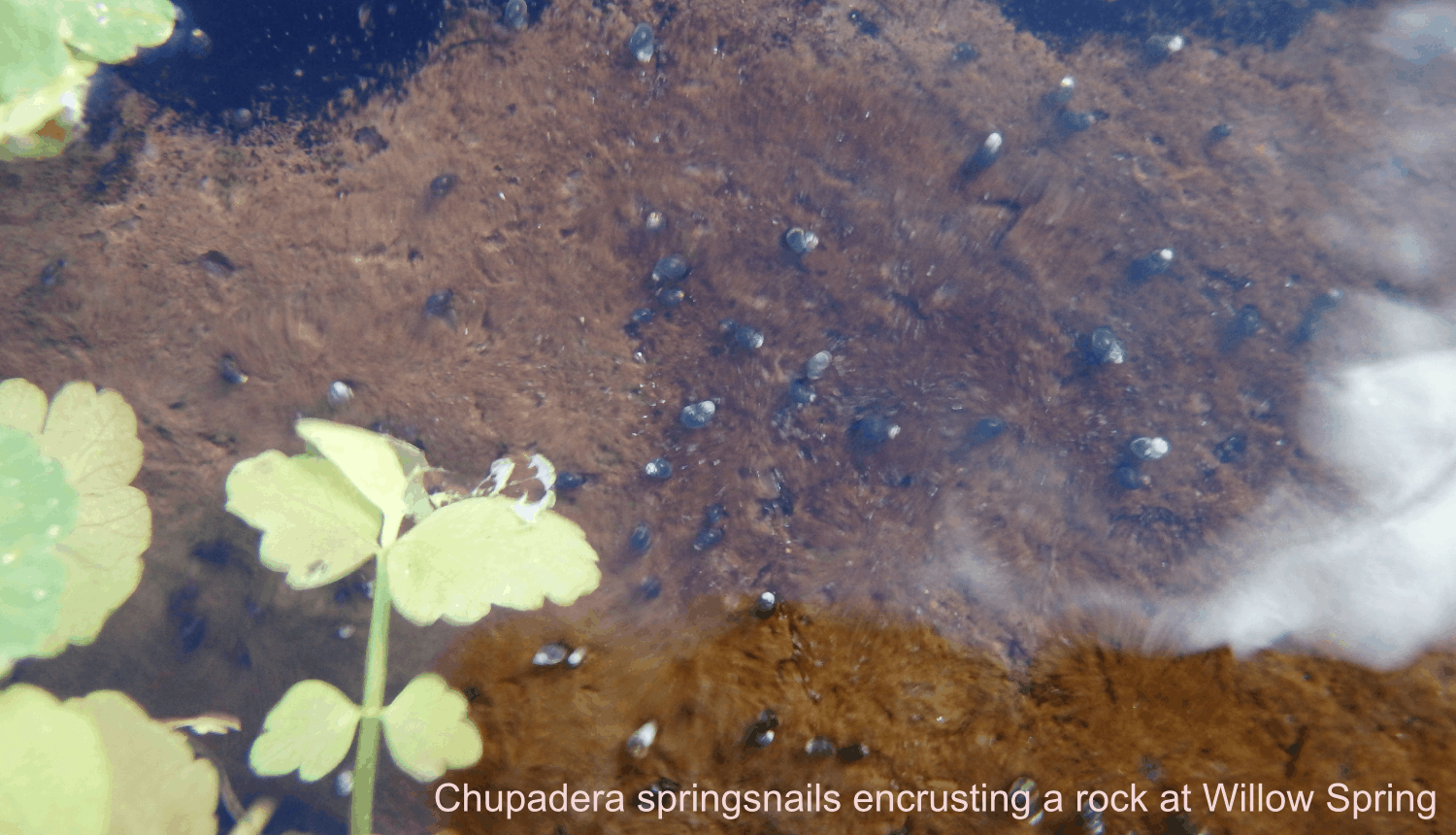
Species
Chupadera springsnail (Pyrgulopsis chupaderae)
Principal Biologist(s)
Magnus McCaffery
Project Location
Willow Spring, NM
Project Partners
Highland Springs Ranch, LLC
US Fish & Wildlife Service
New Mexico Department of Game & Fish
Albuquerque BioPark Aquatic Conservation Facility
Conservation Problem
Chupadera springsnails (CSS) are endemic to one spring system and the potential for habitat loss and degradation is very high.
Conservation Status
- Listed as Endangered under the ESA in 2012
- Critical habitat was designated at Willow Spring and a nearby unnamed spring in 2012, although it is unlikely that snails currently exist at the unnamed spring
- Listed as a Species of Greatest Conservation Need in the Rio Grande watershed in New Mexico’s Comprehensive Wildlife Conservation Strategy.
Project Goals
Our goal is to mitigate threats of extinction and assist USFWS in developing a Recovery Plan.
Objectives
We aim to convene a conservation working group and collect basic Chupadera springsnail (CSS) ecological information to inform development of a Recovery Plan. This will include water quality measurements, determining population status, developing an understanding of species life history, and potential establishment of captive populations. implement a comprehensive conservation and recovery program for this species.
Supporting Rationale for Objectives
The CSS is extremely rare and highly endemic and the potential for extinction is greater than with many other imperiled species. Furthermore, very little is known about the species and currently there is no Recovery Plan to guide conservation efforts or provide downlisting/delisting criteria. The Recovery Plan for two similar species found in New Mexico, the Alamosa (Tryonia alamosae) and Socorro (Pyrgulopsis newmexicana) springsnail, provide downlisting/delisting criteria which might also be applicable to CSS. If the Alamosa and Socorro springsnail recovery plan is a guide, then downlisting CSS may require (1) a habitat management plan that provides protection for the springsnail and its habitat and that (2) the habitat management plan has been in place for 5 years and demonstrated that the continued existence of the springsnail is assured. Delisting may require (1) protection of the springsnails’ habitat in perpetuity and (2) the establishment of additional populations as evidenced by recruitment and persistence over a 5-year period.
Strategies
Our approach to providing a more secure future for CSS is founded on four basic tenets: 1) secure and improve CSS habitat at Willow Spring, 2) maintain the existing CSS population at Willow Spring, 3) continue with existing habitat and population monitoring programs as a means to understand CSS life history, and 4) establish a CSS refuge population at the Albuquerque BioPark.
Project Background
The Chupadera springsnail is a small (1-2 mm) freshwater snail that is endemic to Willow Spring. The springsnail was once also found in a nearby unnamed spring but habitat degradation resulted in the extirpation of that population. The springsnail is considered highly susceptible to extinction given the limited extent of and potential threats to available habitat (1 to 6 feet wide x 115 feet long).
In 2014, we finalized an agreement with Highland Springs Ranch allowing us access to the Willow Spring–an important development since access to the site by biologists last occurred in 1998. A site visit in early 2015 by the last biologist to visit Willow Spring in 1998 was encouraging. CSS densities appeared similar to those last observed and CSS had colonized previously unoccupied habitat further up the spring and water flow from the spring appeared to have increased.
Our approach to providing a more secure future for CSS involves three strategies: 1) secure/improve CSS habitat at Willow Spring, 2) establish a CSS population and habitat monitoring program, and 3) establish a CSS refuge population.
We installed a cattle exclusion fence around Willow Spring in late 2016. We do not fully understand the impacts of cattle on CSS habitat quality and populations, but we assume both will benefit from cattle exclusion. We are closely monitoring the site to document any changes. Also in late 2016, we established standardized habitat and population survey methods comparable to those used from 1997-1998. Quarterly surveys since 2017 have indicated a robust CSS population with some seasonal fluctuations.
Project Activities in 2018
In 2018, we continued quarterly CSS population and habitat surveys at Willow Spring. Since fencing out cattle in late 2017, the physiochemical properties at the spring have stabilized and the total wetted area around the spring run (i.e., springsnail habitat) has increased. In addition, the increased dampness around the spring has benefitted native sedges and rushes to the exclusion of the once dominant and non-native Bermuda grass (Cynodon dactylon). Willow Spring surveys over the last year suggest a CSS population of 2,243,700 individuals with the majority of these individuals occupying a 40-meter stretch along the lower end of the spring.
In late 2018, TESF and the Albuquerque BioPark Aquatic Conservation Center finalized a $10,000 agreement with NMGF to begin the process of developing the facilities and expertise necessary to maintain imperiled New Mexico springsnail species in captivity. The first endangered springsnail species to be included in the refuge program will be the Chupadera springsnail.
Proposed Future Activities & Considerations
In the coming years we will continue with quarterly CSS population and habitat surveys and, in the process, attempt to observe or infer life history milestones. By early 2019, we will have constructed aquariums at the Albuquerque BioPark Aquatic Conservation Center which we will then inoculate with spring water and substrate and soon after two surrogate springsnail species collected from Alum Spring in the Gila Wilderness. We will monitor the two surrogate springsnail species throughout the year and, if there is evidence to indicate the replicated aquarium habitat is suitable and the population is self-sustaining, we will begin the administrative process necessary to bring CSS into captivity.
